Kalundborg,Denmark 作者: 来源: 发布时间:2021-04-14
一、人口,面积,所属地区
Population: 48,436
Area: 604 km²
Municipality in Sjælland
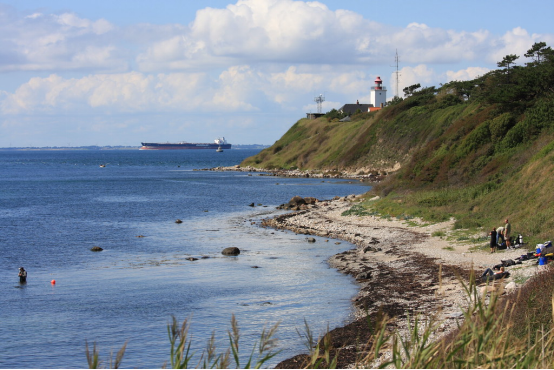
二、自然地理(地理环境、自然资源、交通情况)
Kalundborg municipality is a municipality in Region Sjælland on the west coast of the island of Zealand (Sjælland) in Denmark, and on the opposite, eastern side of which lies Copenhagen, 110 km (68 mi) away. The main town and the site of its municipal council is the city of Kalundborg.
The municipality is surrounded by water on three sides:
Samsø Bælt— the strait which separates the municipality from the island of Samsø— and Sejerø Bay (Sejerø Bugt) — the bay in which the island of Sejerø is located) to the north
The Great Belt (Storebælt)— the strait which separates Zealand from the island of Funen) and the Kattegat to the west
Jammerland Bay (Jammerland Bugt) to the south.
The municipalities of Samsø to the northwest, and Juelsminde on the Jutland peninsula to the west are thus also Kalundborg's municipal neighbors, albeit separated by water.
Ferry lines connect the municipality to Aarhus on the Jutland peninsula, and to the island of Samsø at the central harbour in Kalundborg. The harbour is conveniently located near the Kalundborg train station, which connects to the cities of Holbæk and Copenhagen. A large industrial zone, including a South Harbour, is located south of the town's central area.
Kalundborg is famous as the location of a large broadcasting facility, the Kalundborg transmitter. The city is also home to the largest coal-fired power station in Denmark.
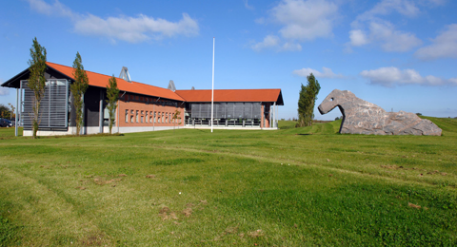
Transport
Kalundborg Municipality works to provide easy access to traffic connections to and from Kalundborg. Development of the infrastructure to and from Kalundborg is necessary for a growing business community.
Kalundborg east
Kalundborg Municipality is actively working to establish a new station Kalundborg Øst at Stejlhøj. The status of the work is:
Novo Nordisk and Kalundborg Municipality have in collaboration prepared an assessment of the passenger base for a new station.
New station will provide approx. 3,500 stationary jobs.
Commuter parking can be set up at the station.
The Swedish Transport Agency has investigated and found that with the new station no problems with regard to roadmap or material consumption will arise. DSB has the same attitude.
Route 22 - The Zealand cross-link
Kalundborg Municipality works to route 22 Kalundborg - Slagelse - Næstved is being extended to the motorway as part of a cross-connection on Zealand.
It will help to secure development opportunities along the route.
Route 23
The Kalundborg motorway continues its growth - the second stage has been adopted
The conciliation parties behind the Traffic Agreement 2014 allocate DKK 427.5 million. DKK to extend the Kalundborg motorway by an additional approx. 6 km. Stage 1 of approx. 6.5 kilometers of motorway was inaugurated on August 27, 2013. It was the Elverdam-Regstrup stretch. Now the next approx. 6 km, which runs south of Regstrup.
Kalundborg Harbor - one of the largest Danish ports
With its location out to the Great Belt, Kalundborg Harbor is close to the well-traveled T-route, which leads in and out of the Baltic Sea and the Baltic.
Kalundborg Harbor is Zealand's largest grain export port and the only public deep-water port in Zealand and a significant part of the regional infrastructure.
三、经济发展和规模
Kalundborg Municipality is home to approximately 19,000 jobs of which 13,000 are in the private sector (December 2014).
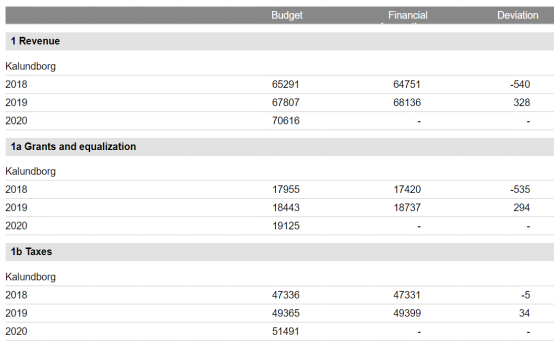
*All amounts are in DKK per. per capita in current prices
四、产业特点重点项目
Novo Nordisk has extensive production facilities in Kalundborg with a total of more than 2,400 employees. Since 1999 they have invested more than DKK 7.5 billions in the complex.
Pronova BioPharma Danmark, a bulk manufacturer of Omega-3 products which was acquired by BASE in 2014, also has a manufaction plan in Kalundborg.
Statoil Refining Denmark operates Denmark's largest oil refinery on the harbor with a capacity of 6.6 million ton oil products per year.
Haldor Topsøe is one of the companies that has facilities at Kalundborg Tank Terminal.
Port of Kalundborg
The port plays a centroal role in the town's economy. It is a municipal self-governing port with independent finances. Kalundborg Container Terminal is served by Unifeeder on a weekly basis. Schultz Shipping is a local shipping company. As of 2015, the port is being expanded with a new west harbor on the south side of the Asnæs peninsula.
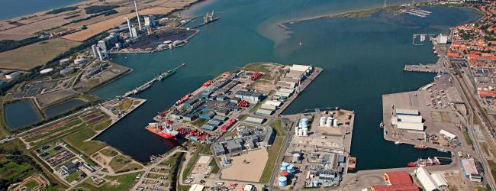
The Industrial Symbiosis Project
The industrial symbiosis project at Kalundborg, Denmark is a model of environmental sustainability. It provides a vision of what is possible. The project has attracted a good deal of international attention, notably by the European Community, and been awarded several environmental prizes.
The symbiosis project, however, is not the result of a careful environmental planning process. It is rather the result of a gradual cooperative evolution of four neighboring industries and the Kalundborg municipality. Although begun by chance, the project has now developed into a high level of environmental consciousness in which the participants are constantly exploring new avenues of environmental cooperation.
In short, the symbiosis project is a process whereby a waste product in one industry is turned into a resource for use in one or more other industries. It is the essence of a well-functioning ecosystem. The Kalundborg experience shows that cooperation among different industries in the use of waste increases the viability of the industries. At the same time, the demands from society for resource conservation and environmental protection are met.
Four industrial facilities—a power plant, an oil refinery, a plaster-board manufacturing plant, and a biotechnology production facility—and the local municipality participate in the Kalundborg symbiosis.
The power plant, Denmark's largest, is owned by Asnæsværket. It is coal fired, has a capacity of 1,500 megawatts (mW), and employs about 600 people.
The oil refinery, Denmark's largest, is owned by Statoil. The refinery has a capacity of about 3 million tons per year (tons/yr) and is being expanded to a capacity of 5 million tons/yr. It employs about 250 people.
The plaster-board manufacturing plant, owned by Gyproc a.s., produces about 14 million square meters per year of plaster-board for the building industry. It employs about 175 people.
The biotechnology facility is owned by Novo Nordisk. The company produces about 45 percent of the world market of insulin and about 50 percent of the world market of enzymes. In addition, the company produces substantial quantities of growth hormones and other pharmaceutical products. Novo Nordisk operates in several countries, but the Kalundborg plant, with 1,100 employees, is the company's largest production site.
The most significant achievements of the industrial symbiosis cooperation at Kalundborg are that:
there have been significant reductions in energy consumption and coal, oil, and water use;
environmental impacts have been lessened through reductions in SO2 and CO2 emissions and improved quality of effluent water; and
traditional waste products such as fly ash, sulphur, biological sludge, and gypsum have been converted into raw materials for production.
The symbiosis has created a positive image of Kalundborg as a clean industrial city. Perhaps most significantly, there has been a gradual development of a systematic environmental "way of thinking" that may be applied to many other industrial settings and which may be used in planning new industrial complexes. At Kalundborg, all future projects and/or process modifications will be considered for potential inclusion in the industrial symbiosis network
五、风景名胜,景点
Stately Lerchenborg Castle
Address: Lerchenborg 3, 4400 Kalundborg
Stately Lerchenborg Castle, the traditional seat of the aristocratic Lerche family, is located on the forest-covered Asnæs peninsula. It is one of the finest examples of baroque architecture in Denmark. The home and gardens are open to the public, but is closed during 2005 for restoration. A number of special arrangements take place at the castle during the year, including a Christmas market, music concerts and car shows. The castle was built in 1747 by General Lerche-Lerchenborg. In the southern side wing is a room dedicated to Hans Christian Andersen who was guest in 1862.
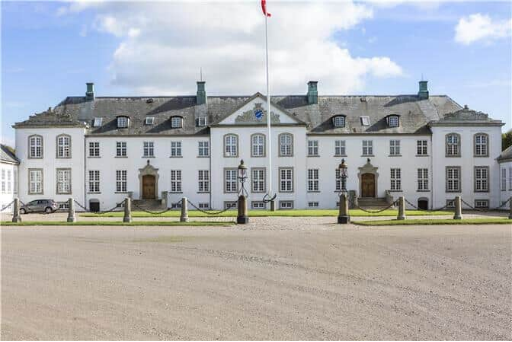
The Church of Our Lady
Address: Adelgade 19, 4400 Kalundborg
The Church of Our Lady is a historical building in Kalundborg, northwestern Zealand, Denmark. The precise date of construction is not known with any certainty, though its architecture indicates the early part of the 13th century. With its five distinctive towers, it stands on a hill above the harbour, making it the town's most imposing landmark.
It is a beautiful and unique, five-spired church which is believed to have been built by Esbern Snare. It is closely associated with King Valdemar I and the famous Archbishop Absalon. The city center has cobblestone streets, narrow streets, and well-preserved half-timbered houses from the Middle Ages.
The plan is in the form of a Greek cross with four arms of equal length. The window arches as well as the pilasters and sunken columns inside the church suggest the involvement of Lombard builders from northern Italy. It is said to be Denmark's most important contribution to architecture during the Middle Ages.
The church's central tower, known as Mary's tower (after the Virgin Mary), is 44 m tall and square-shaped while the four lateral towers, each 34 m tall, are octagonal. The other towers are also named after saints: St. Anne's to the east, St. Gertrude's to the west, St. Mary Magdalene's to the south and St. Catherine's to the north. The four columns supporting the central tower are made of granite, providing additional strength. With five towers in all, the church is unique.
The architecture reveals similarities with the Church of the Holy Sepulchre, as well as with grouped towers in the great churches of France and the Rhineland. In particular, both the church's age and its architectural style have much in common with Tournai Cathedral in the south of Belgium. The masonry, on the other hand, is comparable to that of other early brick buildings in the area such as St. Bendt's Church in Ringsted.
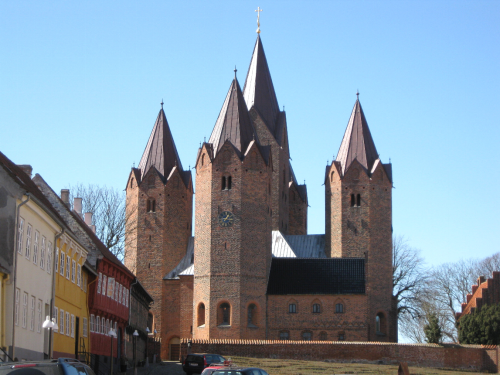
六、历史文化
The Kalundborg area was first settled in 1170 at a natural harbour at the head of the narrow bay today known as Kalundborg Fjord. It became more urbanized during the nineteenth century and had grown into a major industrial centre by the mid-twentieth century.
Kalundborg Municipality’s network is the most published example of Industrial Symbiosis. The history of Kalundborg Industrial Symbiosis activities began in 1961 when a project was developed and implemented to use surface water from Lake Tisso for a new oil refinery, to save the limited supplies of ground water. The City of Kalundborg took the responsibility for building the pipeline while the refinery financed it. Starting from this initial collaboration, a number of other collaborative projects were subsequently introduced and the number of partners gradually increased.
By the end of the 1980s, the partners realised that they had effectively "self-organised" into what is probably the best-known example of Industrial Symbiosis. The material exchanges in the Kalundborg region include: conservation of natural and financial resources; reduction in production, material, energy, insurance and treatment costs and liabilities; improved operating efficiency; quality control; improved health of the local population and public image; and realisation of potential income through the sale of by-products and waste materials.
On January 1, 2007 Kalundborg municipality was, as the result of Kommunalreformen ("The Municipal Reform" of 2007), merged with existing Gørlev, Hvidebæk, Bjergsted, and Høng municipalities to form the new Kalundborg municipality.
Kalundborg is a mainly trading and industrial town, but is also well known for the beautiful five-spired Church of Our Lady, which is closely associated with King Valdemar I and the famous Archbishop Absalon. The church itself is said to have been built by Absalon's brother, Esbern Snare.
Kalundborg is also the traditional seat of the aristocratic Lerche family. Their stately home, Lerchenborg, the best example of rococo architecture in Denmark, can be seen in the town's outskirts.
Kalundborg is the birthplace of the Norwegian Nobel laureate author Sigrid Undset, who lived there during the first two years of her life, before her parents emigrated to Norway in 1884.
七、其他信息
Kalundborg has one of the largest business areas in Zealand outside Copenhagen.
Biotech Village
Knowledge Hub Zealand is building a biotech production center in Kalundborg. The vision is to create a world-leading center for development, innovation and education.
Knowledge Hub Zealand will house an advanced development center for biotech production, an innovation environment for biotech startups and a training center for biotechnology, process and production.
Knowledge Hub Zealand is established as a strong partnership in a partnership, founded as an association. The Board of Directors consists of Region Zealand, Kalundborg Municipality, Novo Nordisk, Roskilde University, University of Southern Denmark, Absalon University of Applied Sciences and the Business Academy of Zealand.
With a balanced and collaborative focus on productivity, education and green change, the biotech's response to Silicon Valley is created. Therefore, the good people of the world are doing well. For inspiration and to join.
八、联系方式
Mayor: Martin Damm
Address: Holbækvej 141B, 4400 Kalundborg
Telephone: 59 53 44 00
mail: kalundborg@kalundborg.dk
Facebook: https://www.facebook.com/Kalundborgkommune/
Website: https://www.kalundborg.dk/
